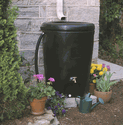






| Individiual Housing level Water Supplies |
| Introduction | | Individual Housing level | Neighborhood level | Village/Community level | References |
| Rain water harvesting on the individual housing scale | ||||
Falling rain can provide some of the cleanest naturally occurring water that is available. This is result of a natural distillation process that is at risk only from airborne particles and from man-made pollution caused by the smoke and ash of fires and industrial processes, particularly those which burn fossil fuels. The term “rainwater harvesting” is usually taken to mean “the immediate collection of rainwater running off surfaces upon which it has fallen directly”. This definition excludes run-off from land watersheds into streams, rivers, lakes, etc. |
| Rain water collection Barrels | ||||
      |
| Materials | ||||||||||||||||||||||||
|
||||||||||||||||||||||||
|
||||||||||||||||||||||||
|
||||||||||||||||||||||||
Storage |
||||||||||||||||||||||||
The capacity of the storage tank is based upon several design criteria: rainfall patterns and volume, the duration of the dry period and, of course, the estimate of demand. Sometimes sophisticated calculations are involved, but these tend not to take into account human behaviour and the willingness to use water if it is available and not to conserve it for future use, in the hope that the dry spell will soon be over. The provision of the storage tank is the most costly element of a rainwater harvesting project, usually about 90% of the total cost. Storage can range from small containers made for other purposes, for example oil drums, food cans, etc., but used as domestic storage, up to large tanks of 150 cu. metres or more at ground level, or sometimes beneath it; these are made of concrete or ferrocement and are used as storage for schools, clinics or other institutions with large areas of roof.
|
||||||||||||||||||||||||
Maintenance |
||||||||||||||||||||||||
|
||||||||||||||||||||||||
| Advantages/Disadvantages |
Advantages
Disadvantages
|